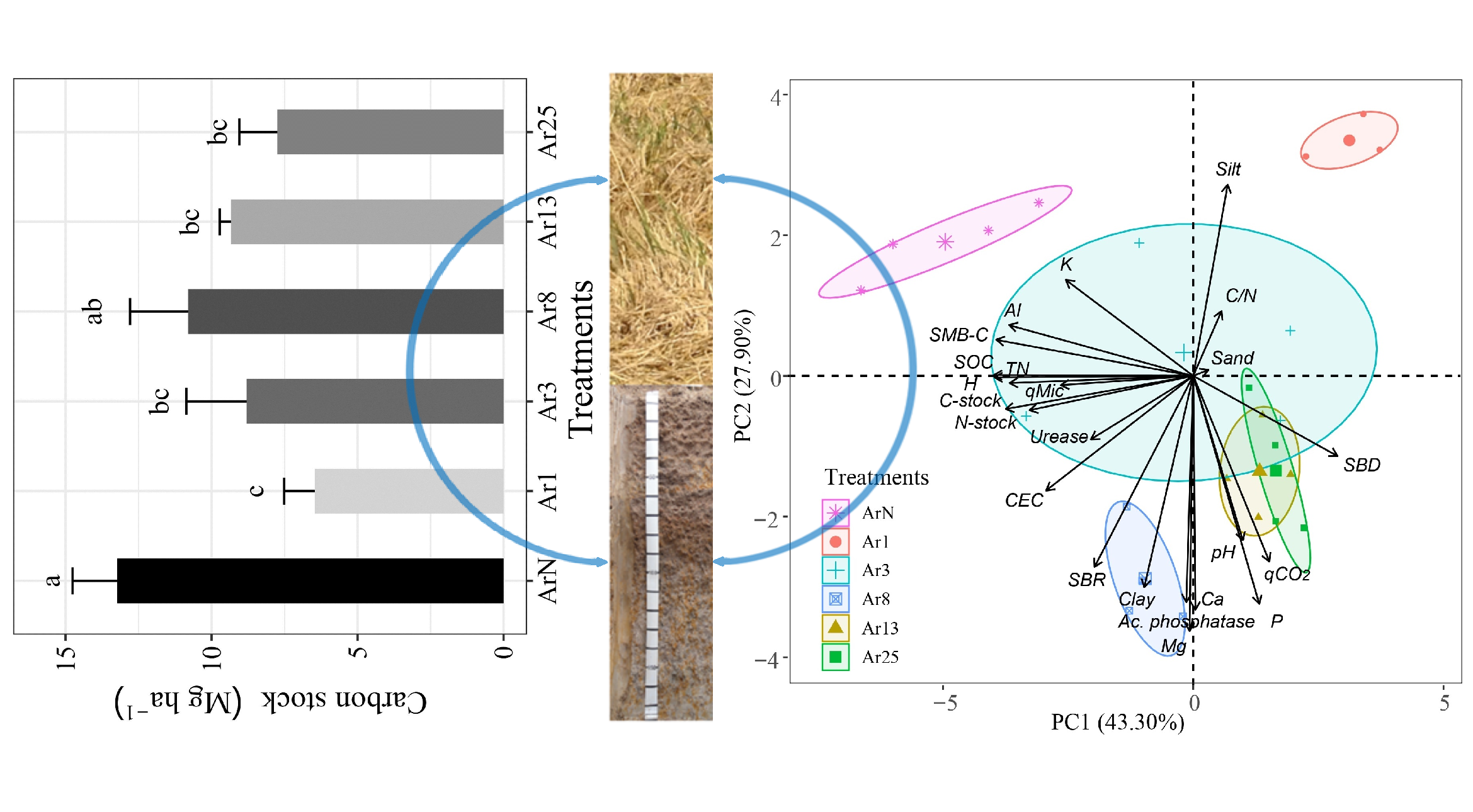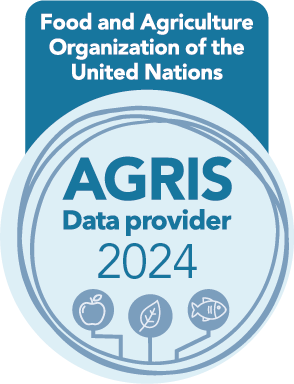Long-Term impact of rice cultivation on soil quality indicators in Northern Amazonia Savanna
DOI:
https://doi.org/10.17268/sci.agropecu.2025.012Palabras clave:
enzymatic activity, soil microbiology, soil indicators, Amazon soilsResumen
Changes in soil attributes following changes in management strategies in rice cultivation can alter soil quality, either positively or negatively. The aim of this study was to evaluate soil quality indicators, based on physical, chemical and microbiological soil attributes in Amazonian savanna under rice cultivation with different ages. The research was conducted in five areas under continuous rice cultivation during 1, 3, 8, 13, and 25 years, compared with local reference native vegetation. Soil samples were collected at 0-10 cm depth and evaluated for physical attributes such as texture and bulk density, chemical properties such as soil organic carbon, total nitrogen, exchangeable cations, available P, pH, CEC and C/N ratio; and microbiological attributes like microbial biomass carbon, soil microbial respiration, metabolic ratio and microbial coefficient. Acid phosphatase and urease activity were evaluated. With longer periods of time of rice cultivation, soil quality was enhanced with increasing soil fertility, increased soil organic carbon content and enzyme activity. The paddy soil indicators were sensitive to changes in rice cultivation and its duration. Acid phosphatase activity and available phosphorus increased with longer time of rice cultivation, indicating a possible conversion of inorganic into organic phosphorus forms, corroborated by increasing phosphatase activity. Microbiological (SMB-C, SBR, qMIC and qCO2) and biochemical (urease and acid phosphatase) indicators, as well as soil organic carbon and total nitrogen were highly sensitive to land use changes. Chemical and microbiological indicators are suitable for estimating paddy soil quality in lowland of Amazonian savanna.
Citas
Anderson, T. H., & Domsch, K.H. (1993). The metabolic quotient for CO2 (qCO2) as a specific activity parameter to assess the effects of environmental conditions, such as pH on the microbial biomass of forest soils. Soil Biology Biochimestry Journal, 25, 393-395. https://doi.org/10.1016/0038-0717(93)90140-7
Anjos, L.H.C., & Schad, P. (2018). Comparação da classificação de solos de acordo com o Sistema Brasileiro e os Sistemas Internacionais WRB e Soil Taxonomy. In: Batista KD, Lumbreras J F, Coelho MR, Oliveira VA, Vale Júnior JF. (Eds.), Guia de Campo da XI Reunião Brasileira de Classificação e Correlação de Solos: RCC de Roraima (pp. 305-311). Embrapa.
Araújo, W. F., Monteiro Neto, J. L., Sander, C., Albuquerque, J A. A., Viana, T. V. A., & Valero, M. A. M. (2024). Atualização da classificação climática de Boa Vista, Roraima, Brasil. Nativa, 12(2), 236-240. https://doi.org/10.31413/nat.v12i2.16202
Barberena, D.S., Medeiro, R.D., & Barbosa, G.F. (2011). Desenvolvimento e produtividade de arroz irrigado em resposta a diferentes doses de fósforo e potássio, em várzea de primeiro ano, no estado de Roraima. Ciência Agrotecnologia, 35, 462-470. https://doi.org/10.1590/S1413-70542011000300004
Borase, D. N., Nath, C. P., Hazra, K. K., Senthilkumar, M., Singh, S. S., Praharaj, C. S., Singh, U., & Kumar, N. (2020). Long-term impact of diversified crop rotations and nutrient management practices on soil microbial functions and soil enzymes activity. Ecological Indicators, 114, 1-11.https://doi.org/10.1016/j.ecolind.2020.106322
Brady, N. C., & Weil, R. R. (2016). The Nature and Properties of Soils (15th ed.). Peorson, New York, NY, USA.
Carvalho, F., Moreira, F. M. S., & Cardoso, E. J. B. N. (2012). Chemical and biochemical properties of Araucaria angustifolia (Bert.). Forest soils in the state of São Paulo. Revista Brasileira Ciência do Solo, 36, 1189-1201. https://doi.org/10.1590/S0100-06832012000400013
CQFS-RS/SC - Comissão de Química e Fertilidade do Solo. (2004). Manual de adubação e de calagem para os estados do Rio Grande do Sul e Santa Catarina. SBCS/Núcleo Regional Sul, Porto Alegre, RS, Brazil.
Cruz, C. D., & Regazzi, A. J. (2001). Modelos biométricos aplicados ao melhoramento genético. 2.ed. rev. UFV. Viçosa, MG, Brazil, 390p.
Embrapa. (2009). Manual de métodos de análise de solo, plantas e fertilizantes (2nd ed.). Embrapa Solos, Rio de Janeiro, RJ, Brazil.
Eshun, L. E., García‑López, A. M., Recena, R., Coker, V., Shaw, S., Lloyd, J., & Delgado, A. (2024). Assessing microbially mediated vivianite as a novel phosphorus and iron fertilizer. Chemical and Biological Technologies in Agriculture, 11(47), 1-14. https://doi.org/10.1186/s40538-024-00558-0
Evald, A., Melo, V. F., Rocha, P. R. R., Maia, S. S., & Espindola, I. C. (2021). Soil attributes under different water management systems of rice paddies in the amazonian savanna of Brazil. Revista Caatinga, 34(3), 640-649. http://dx.doi.org/10.1590/1983-21252021v34n316rc
FAO - Food and Agriculture Organization of the United Nations (2021). The State of Food Security and Nutrition in the World 2021: Transforming Food Systems for Food Security, Improved Nutrition and Affordable Healthy Diets for All. FAO, IFAD, UNICEF, WFP and WHO. Rome 2021. 2011p. https://doi.org/10.4060/cb4474en
Ghestem, M., Sidle, R.C., & Stokes, A. (2011). The Influence of plant root systems on subsurface flow: implications for slope stability. BioScience, 61, 869-879. https://doi.org/10.1525/bio.2011.61.11.6
Hamza, M.A., & Anderson, W.K. (2005). Soil compaction in cropping systems: A review of the nature, causes and possible solutions. Soil & Tillage Research, 82, 121-145. https://doi.org/10.1016/j.still.2004.08.009
Hoffland, E., Kuyper, T. W., Comans, R. N. J., & Creamer, R. E. (2020). Eco-functionality of organic matter in soils. Plant Soil, 455, 1–22. https://doi.org/10.1007/s11104-020-04651-9
Jenkinson, D. S., & Powlson, D. S. (1976). The effects of biocidal treatments on metabolism in soil. A method for measuring soil biomass. Soil Biology and Biochemistry, 8, 209-213. https://doi.org/10.1016/0038-0717(76)90005-5
Kandeler, E., & Gerber, H. (1988). Short-term assay of soil urease activity using colorimetric determination of ammonium. Biology and Fertility Soil, 6, 68-72.
Kaur, G., Singh, G., Motavalli, P. P., Nelson, K. A., Orlowski, J. M., & Golden, B. R. (2020). Impacts and management strategies for crop production in waterlogged or flooded soils: A review. Agronomy Journal, 112, 1475–1501. https://doi.org/10.1002/agj2.20093
Kirkegaard, J. A., Richardson, A. E., & Kirkby, C. A. (2023). Fate and cost effectiveness of soil carbon sequestered using supplementary nutrients applied to crop residues under field conditions. Nutrient Cycling Agroecosyst, 126, 143–161. https://doi.org/10.1007/s10705-023-10272-2
Kögel-Knabner, I. Amelung, L.; Zhihong, C., Fiedler, S., Frenzel, P., Jahn, R., Kalbitz, K., Kölbl, A., & Schloter, M. (2010). Biogeochemistry of paddy soils. Geoderma, 157, 1-14. https://doi.org/10.1016/j.geoderma.2010.03.009
Konstantinou, C., Wang, Y., Biscontin, G., & Soga, K. (2021). The role of bacterial urease activity on the uniformity of carbonate precipitation profiles of bio‑treated coarse sand specimens. Nature Scientific Reports, 11, 6161. https://doi.org/10.1038/s41598-021-85712-6
Laurentiis, V., Maier, S., Horn, R., Uusitalo, V., Hiederer, R., Chéron‑Bessou, C., Morais, T., Grant, T., Canals, L. M., & Sala, S. (2024). Soil organic carbon as an indicator of land use impacts in life cycle assessment. The International Journal of Life Cycle Assessment, 29, 1190–1208.https://doi.org/10.1007/s11367-024-02307-9
Lee, C.H., Hong, C. O., Kim, S. Y., Schumacher, T., & Kim, P. J. (2011). Reduction of phosphorus release by liming from temporary flooded rice rotational system in greenhouse upland soil. Ecological Engineering, 37, 1239-1243. https://doi.org/10.1016/j.ecoleng.2011.02.014
Li, J. Y., Chen, P., Li, Z. G., Li, L. Y., Hu, W., & Liu, T. (2023). Soil aggregate-associated organic carbon mineralization and its driving factors in rhizosphere soil. Soil Biology and Biochemistry, 186, 109182. https://doi.org/10.1016/j.soilbio.2023.109182
Li, Q., Yang, J., He, G., Liu, X., & Zhang, D. (2022). Characteristics of soil C:N:P stoichiometry and enzyme activities in different grassland types in Qilian Mountain nature reserve-Tibetan Plateau. Plos One, 17, e0271399. https://doi.org/10.1371/journal.pone.0271399
Lima, A. C. R., Brussaard, L., Totola, M. R., Hoogmoed, W. B., & Goede, R. G. M. (2013). A functional evaluation of three indicator sets for assessing soil quality. Applied Soil Ecology, 64, 194–200. https://doi.org/10.1016/j.apsoil.2012.12.009
Liu, S., Tang, Z., Shen, C., Wang, T., & Liang, Y. (2023). Effect of rice stubble on soil compaction properties of a crawler Undergoing combine harvester harvesting. Engenharia Agrícola, 43(3), e20230057. https://doi.org/10.1590/1809-4430-Eng.Agric.v43n3e20230057/2023
Martinengo, S., Schiavon, M., Santoro, V., Said‑Pullicino, D., Romani, M., Miniotti, E. F., Celi1, L., & Martin, M. (2023). Assessing phosphorus availability in paddy soils: the importance of integrating soil tests and plant responses. Biology and Fertility of Soils, 59, 391–405. https://doi.org/10.1007/s00374-023-01714-8
Medeiros, R. D., Soares, A. A., & Guimarães, R. M. (2005). Compactação do solo e manejo da água. I: efeitos sobre a absorção de N, P, K, massa seca de raízes e parte aérea de plantas de arroz. Ciência Agrotécnica, 29, 940-947. https://doi.org/10.1590/S1413-70542005000500004
Omer, M., Idowu, O. J., Pietrasiak, N., VanLeeuwen, D., Ulery, A. L., Dominguez, A. J., Ghimire, R., & Marsalis, M. (2023). Agricultural practices influence biological soil quality indicators in an irrigated semiarid agro-ecosystem. Pedobiologia, 96, 150862. https://doi.org/10.1016/j.pedobi.2022.150862
Provam - Programa de várzeas da Amazônia. (1996). Caracterização dos solos, avaliação da aptidão agrícola das terras e indicativo de culturas para as várzeas do cerrado do estado de Roraima. SUDAM/OEA/CPATU, Belém, PA, Brazil.
R Core Team (2023). R: A Language and Environment for Statistical Computing; R Foundation for Statistical Computing: Vienna, Austria. Available online: https://www.R-project.org/
Rao, D., Meng, F., Yan, X., Zhang, M., Yao, X., Kim, K. S., Zhao, J., Qiu, Q., Xie, F., & Zhang, W. (2021). Changes in Soil Microbial Activity, Bacterial Community Composition and Function in a Long-Term Continuous Soybean Cropping System After Corn Insertion and Fertilization. Frontier in Microbiology, 12, 638326. https://doi.org/10.3389/fmicb.2021.638326
Sakazaki, R.T., Alves J.M.A., & Lopes, G.N. (2008). Arroz Irrigado em Roraima. Agro@mbiente On-line, 2, 69-76. https://doi.org/10.18227/1982-8470ragro.v2i1.166
Sarto, M. V. M., Wander L.B., Borges, W. L. B., Sarto, J. R. W., Carlos A.B. Pires, C. A. B., Rice, C. W., & Rosolem, C. A. (2020). Soil microbial community and activity in a tropical integrated crop-livestock system. Applied Soil Ecology, 145, 103350. https://doi.org/10.1016/j.apsoil.2019.08.012
Soil Survey Staff. (2022). Keys to Soil Taxonomy (13th ed.). USDA-Natural Resources Conservation Service.
Tabatabai, A. (1994). Soil enzymes. In: Weaver, R.W., Angle, J.S., Bottomley, P.S. (Eds.), Methods of soil analyses. Part 2. Microbiological and biochemical properties (pp. 775-833). 2nd ed. Madison: Soil Science Society of America. https://doi.org/10.2136/sssabookser5.2.c37
Tang, Y., Luo, L., Carswell, A., Misselbrook, T., Shen, J., & Han, J. (2021). Changes in soil organic carbon status and microbial community structure following biogas slurry application in a wheat-rice rotation. Science of the Total Environment, 757, 143786. https://doi.org/10.1016/j.scitotenv.2020.143786
Tate, K.R., Ross, D.J., & Feltham, C.W. (1988). A direct extraction method to estimate soil microbial C: effects of experimental variables and some different calibration procedures. Soil Biology Biochemistry, 20, 329-335. https://doi.org/10.1016/0038-0717(88)90013-2
Tomobe, H., Tsugawa, S., Yoshida, Y., Arita, T., Tsai, A. Y. L., Kubo, M., Demura, T., & Sawa, S. (2023). A mechanical theory of competition between plant root growth and soil pressure reveals a potential mechanism of root penetration. Nature Scientific Reports, 13, 7473. https://doi.org/10.1038/s41598-023-34025-x
Vitali, A., Moretti, B., Bertora, C., Miniotti, E. F., Tenni, D., Romani, M. & Said-Pullicino, D. (2024). The environmental and agronomic benefits and trade-offs linked with the adoption alternate wetting and drying in temperate rice paddies. Field Crops Research, 317, 109550. https://doi.org/10.1016/j.fcr.2024.109550
Zhou, J., Sun, T., Shi, L., Kurganova, I., Gerenyu, V. L., Kalinina, O., Giani, L., & Kuzyakov, Y. (2023). Organic carbon accumulation and microbial activities in arable soils after abandonment: A chronosequence study. Geoderma, 435, 116496. https://doi.org/10.1016/j.geoderma.2023.116496

Descargas
Publicado
Cómo citar
Número
Sección
Licencia
Derechos de autor 2025 Scientia Agropecuaria

Esta obra está bajo una licencia internacional Creative Commons Atribución-NoComercial 4.0.
Los autores que publican en esta revista aceptan los siguientes términos:
a. Los autores conservan los derechos de autor y conceden a la revista el derecho publicación, simultáneamente licenciada bajo una licencia de Creative Commons que permite a otros compartir el trabajo, pero citando la publicación inicial en esta revista.
b. Los autores pueden celebrar acuerdos contractuales adicionales separados para la distribución no exclusiva de la versión publicada de la obra de la revista (por ejemplo, publicarla en un repositorio institucional o publicarla en un libro), pero citando la publicación inicial en esta revista.
c. Se permite y anima a los autores a publicar su trabajo en línea (por ejemplo, en repositorios institucionales o en su sitio web) antes y durante el proceso de presentación, ya que puede conducir a intercambios productivos, así como una mayor citación del trabajo publicado (ver efecto del acceso abierto).




